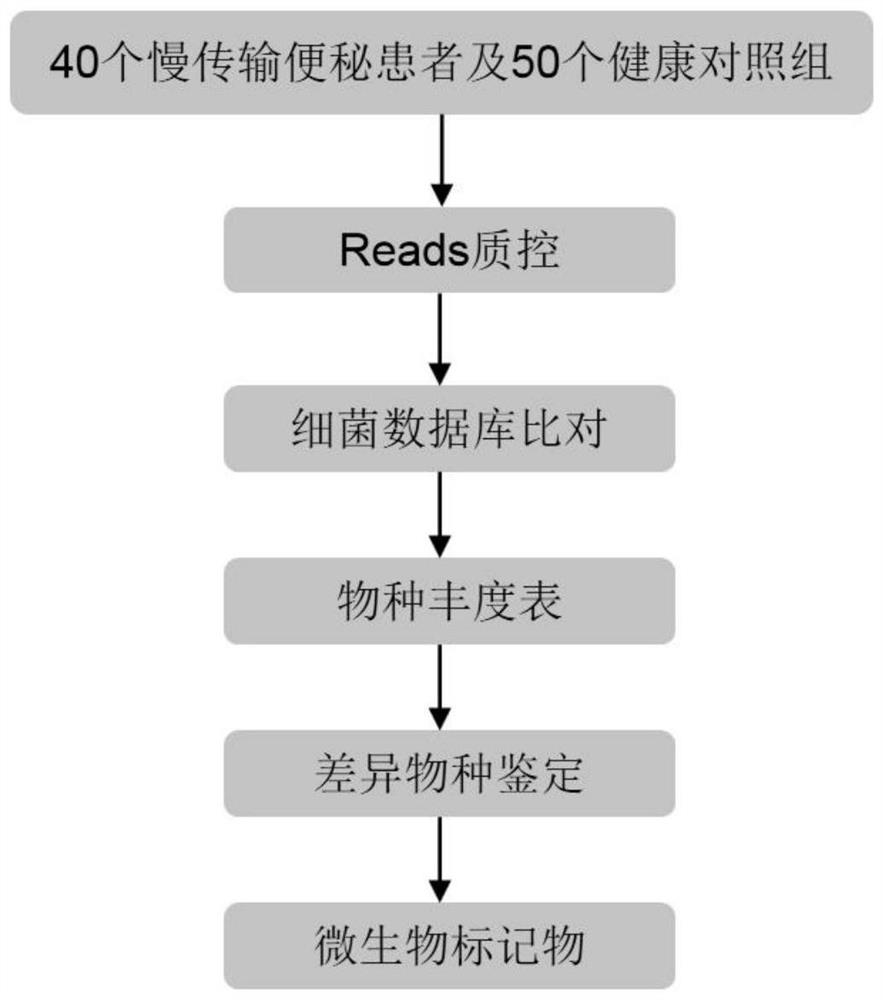Slow-transit constipation marking microorganism and application thereof
A technology of microorganisms and markers, applied in the direction of microorganisms, microorganism-based methods, and the determination/inspection of microorganisms, which can solve problems such as lack of bowel movements, bad living habits, abnormal hormone levels, etc.
- Summary
- Abstract
- Description
- Claims
- Application Information
AI Technical Summary
Problems solved by technology
Method used
Image
Examples
Embodiment 1
[0064] Example 1 Identification of biomarkers
[0065] In this example, the inventors studied 118 stool samples from the Tenth People's Hospital Affiliated to Tongji University, including 52 stool samples from patients with slow transit constipation and 66 stool samples from Chinese healthy controls. We divided the 118 samples into phase I and phase II, 90 samples in the first phase (including 40 patients with slow transit constipation and 50 normal subjects), 28 samples in the second phase (including 12 patients with slow transit constipation and 16 normal subjects). people). In Example 1, 118 samples were processed uniformly, including sample collection and DNA extraction, DNA library construction and sequencing, and microbial species abundance analysis. In Example 2, the screening of microbial species markers was carried out with 90 cases of Phase I data. In Example 3, the second-phase data of 28 cases were used to verify the microbial species markers.
[0066] 1. Sample...
Embodiment 2
[0092] Example 2 Screening for microbial species markers
[0093] In order to obtain markers of intestinal microbial species closely related to slow transit constipation disease, the inventors used the data of 90 cases of slow transit constipation patients group (40 cases) and normal control group (50 cases) to obtain intestinal microbial species markers. degree data, a study on the correlation with disease was done at the species level. Based on the species abundance table obtained in Example 1, the inventors set the standard as follows: (1) by combining the Wilcoxon rank sum test of Benjamini Hochberg's multiple test, the correlation p value of each species and slow transit constipation disease is obtained and q value; (2) Use a strict threshold (q value <0.04) to screen using the above parameters. The inventor obtained 7 intestinal microbial species closely related to slow transit constipation disease, and the data analysis is shown in Table 1, among which, there are 7 spe...
Embodiment 3
[0096] Verification of Example 3 Microbial Species Marker
[0097] In order to confirm the findings in Example 2, the inventors referred to the method described in Example 2 to determine the feces samples of 16 healthy people and 12 patients with slow transit constipation (28 cases of second-phase data) in the verification group. Show the abundance of 7 kinds of bacteria, and judge whether these 7 kinds of bacteria abundances of each sample species fall into the 95% confidence interval of the disease group or the healthy group determined in embodiment 2, determine the abundance of 7 kinds of bacteria The state of the individual corresponding to the sample whose abundance falls into the corresponding interval of the disease group is the patient with slow transit constipation, and the state of the individual corresponding to the sample whose abundance of the seven bacterial species falls within the corresponding interval of the healthy group is the patient with non-slow transit c...
PUM
 Login to View More
Login to View More Abstract
Description
Claims
Application Information
 Login to View More
Login to View More - R&D
- Intellectual Property
- Life Sciences
- Materials
- Tech Scout
- Unparalleled Data Quality
- Higher Quality Content
- 60% Fewer Hallucinations
Browse by: Latest US Patents, China's latest patents, Technical Efficacy Thesaurus, Application Domain, Technology Topic, Popular Technical Reports.
© 2025 PatSnap. All rights reserved.Legal|Privacy policy|Modern Slavery Act Transparency Statement|Sitemap|About US| Contact US: help@patsnap.com



